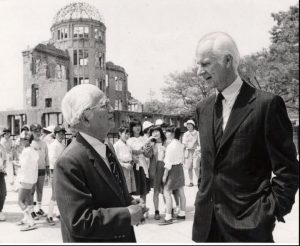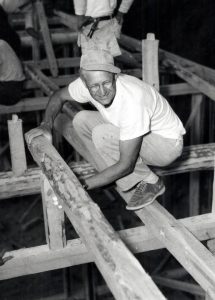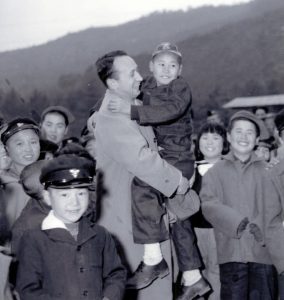Striving to fill voids in Hiroshima, Chugoku Shimbun and the press code — Surveillance of articles with A-bombing content, Part 6: Three Americans
Sep. 27, 2023
GHQ wary of journalist John Hersey
John Hersey (1914–1993), Norman Cousins (1915–1990), and Floyd Schmoe (1895–2001) were among the first Americans to visit the ruins of Hiroshima after the atomic bomb was dropped on the city, report to the world about the situation there, and provide aid and support.
Mr. Hersey, a journalist, created a worldwide sensation with his publication Hiroshima, the first account to be shared with the world about the damage caused by the atomic bombing. Mr. Cousins, also a journalist, advocated what was called a “moral adoption” campaign to help Hiroshima war orphans. He also helped bring women suffering from keloid scars caused by the bombing to the United States for medical treatment. Mr. Schmoe, a peace activist, proceeded to build housing for A-bomb survivors. He was a Quaker who adhered to pacifism.
Clear differences in censorship
The activities of the three Americans were often also featured in the pages of the Chugoku Shimbun newspaper, which was bound by the press code that had been imposed on the media by the General Headquarters (GHQ) of the Allied Powers. However, there were clear differences in the level of censorship used for the three.
The only articles about the three Americans that were censored were those that covered Mr. Hersey. A total of 30 articles about him were published in the Chugoku Shimbun between March 1946 and October 1949, and 20 of those articles were censored. Of the remaining 10 articles, eight were not censored, with the status of the other two unclear.
In contrast, none of the nine articles published about Mr. Cousins were censored. There were 14 articles that directly featured Mr. Schmoe, but none of those articles were censored. From that, it seems clear that the GHQ was wary of Mr. Hersey.
Mr. Hersey visited Hiroshima City in May 1946 and stayed for about three weeks. He interviewed six A-bomb survivors, including Kiyoshi Tanimoto, minister at the Hiroshima Nagarekawa Church, about their experiences in the atomic bombing and their subsequent lives, publishing Hiroshima in the American literary weekly magazine The New Yorker in August 1946. It has been reported that all 299,046 copies of the magazine sold out on the day of release.
Two months later, the Chugoku Shimbun published an article about the publication’s significant response, titled, “Amerika Genron-kai ni Dai-senpu” (in English, ‘A Great Sensation in the U.S. Media’). The sensation was also featured in the monthly magazine Sekai (‘World’) and other publications.
Although related articles were published, a translation of the original account itself, the most important information, was not published in Japan for some time.
Why? In fact, The New Yorker editorial department had secretly provided a galley proof of Hiroshima to U.S. Army Major General Leslie Groves, director of the A-bomb development program. Investigations by American journalists and Atsuko Shigesawa, associate professor at the Kobe City University of Foreign Studies, revealed that it was effectively a case of “pre-print censorship.” Some have pointed out that those circumstances might have affected the publication of a Japanese version.
Was the GHQ aware of the situation? The Chugoku Shimbun searched for clues in the extensive collection of GHQ-related materials archived in the reference room on constitutional government at Japan’s National Diet Library in Tokyo, but was unable to verify whether or not that was the case.
Japanese version took more than two years to publish
A Japanese version of the account was approved for publication in January 1949, with Hosei University Press publishing the translation in April 1949. About two years and eight months had passed since the original publication in The New Yorker.
The Chugoku Shimbun subsequently published seven articles about Mr. Hersey, all of which were left uncensored. Among those articles, one indicated that Hiroshima had been presented to Emperor Hirohito, Empress Kojun, and Crown Prince Akihito, who now holds the title Emperor Emeritus. Ordinarily, articles about the imperial family were censored, making the response unusual. In its investigation, the Chugoku Shimbun was unable to find GHQ documents providing justification for the lack of censorship.
(Originally published on September 27, 2023)










